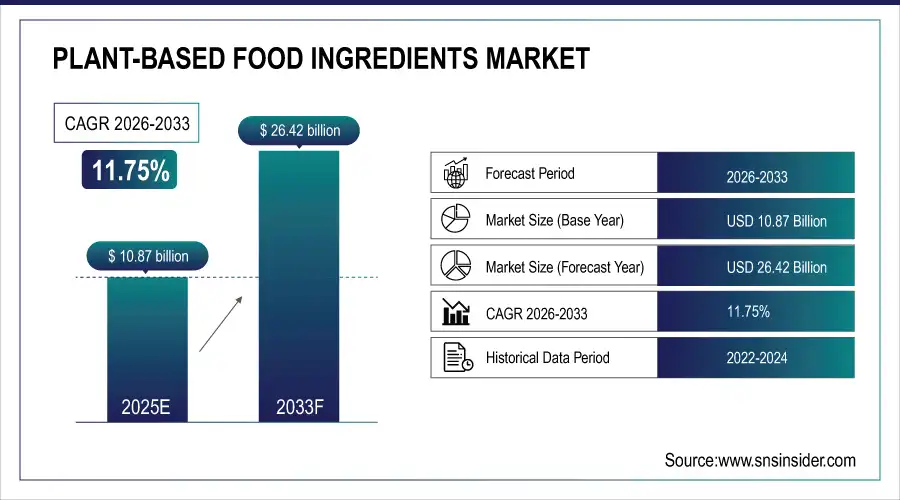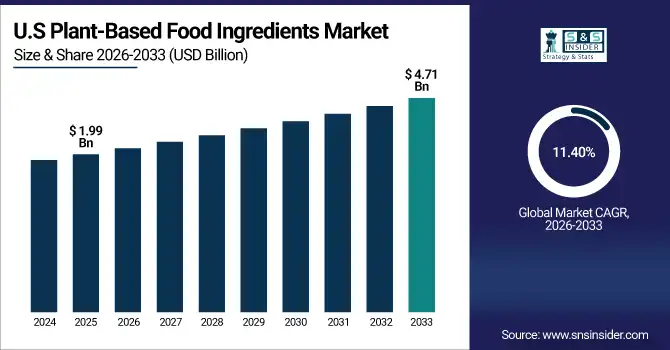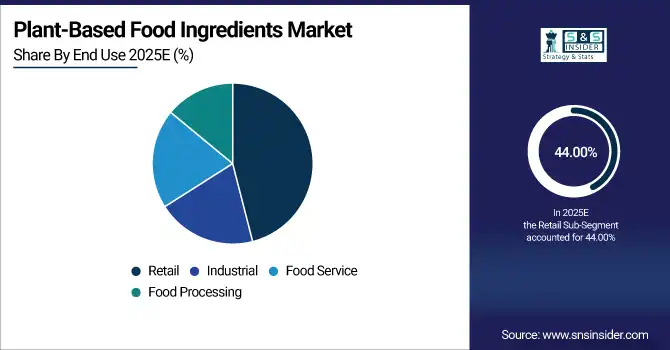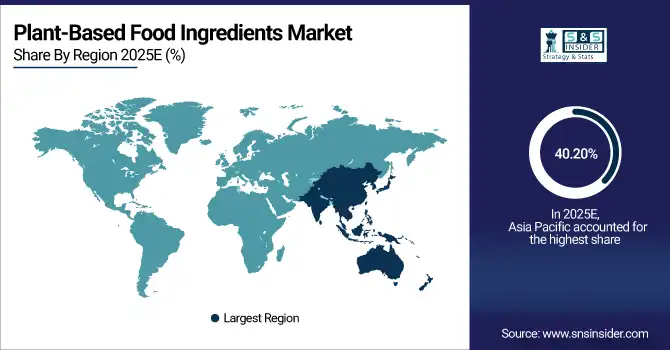Plant-Based Food Ingredients Market Report Scope & Overview:
The Plant-Based Food Ingredients Market Size was valued at USD 10.87 Billion in 2025E and is expected to reach USD 26.42 Billion by 2033 and grow at a CAGR of 11.75% over the forecast period 2026-2033.
The Plant-Based Food Ingredients Market analysis, driven by the growing consumer demand for healthy and sustainable diets, lactose intolerance and allergies, and awareness of the environmental benefits of these alternatives. Advancements in Plant Protein Extraction, Clean-Label Ingredients, and Functional Additives Fuel Adoption in Food, Beverages, and Cosmetics. According to study, around 68% of global consumers are increasingly seeking healthier and sustainable diets, driving plant-based ingredient adoption.
Market Size and Forecast:
-
Market Size in 2025: USD 10.87 Billion
-
Market Size by 2033: USD 26.42 Billion
-
CAGR: 11.75% from 2026 to 2033
-
Base Year: 2025
-
Forecast Period: 2026–2033
-
Historical Data: 2022–2024

To Get more information On Plant-Based Food Ingredients Market - Request Free Sample Report
Plant-Based Food Ingredients Market Trends:
-
Rising demand for plant-based diets drives global adoption of healthier ingredients.
-
Consumers increasingly prefer sustainable food products with low environmental impact globally.
-
Growing vegan and flexitarian populations expand plant-based ingredient consumption worldwide.
-
Innovation in plant protein extraction boosts functionality and market competitiveness.
-
Clean-label and minimally processed ingredients gain popularity among health-conscious consumers.
-
Fortified and functional plant-based products create premium growth opportunities globally.
The U.S. Plant-Based Food Ingredients Market size was USD 1.99 Billion in 2025E and is expected to reach USD 4.71 Billion by 2033, growing at a CAGR of 11.40% over the forecast period of 2026-2033, driven by health-conscious and environmentally aware consumers, rising demand for plant-based proteins and dairy alternatives, and increasing adoption of clean-label, minimally processed, and functional ingredients across food, beverages, and nutraceuticals.

Plant-Based Food Ingredients Market Growth Drivers:
-
Rising Consumer Demand Fuels Plant-Based Ingredients Market Global Growth
The transition to a healthy lifestyle and environmentally friendly options is one of the key factors for the growth of plant-based food ingredients market. Consumers are growing more and more partial to plant-based proteins, fibers, and other functional ingredients in order to prevent chronic diseases, maintain a healthy weight, and promote better gut health. Shoppers around the world have said they are opting for plant-based alternatives out of concern for their health and for sustainability. This is driving demand in categories such meat alternatives, dairy replacements, beverages and functional products. And companies are reacting with new products like pea protein, almond milk and plant-based emulsifiers to accommodate those shifting consumer demands.
Adoption of plant-derived functional ingredients in beverages and foods is increasing by 8–10% annually.
Plant-Based Food Ingredients Market Restraints:
-
High Production Costs Limit Plant-Based Ingredients Market Expansion Globally
Despite growing demand, plant-based ingredients are facing geographical limits due to their higher production costs. Manufacturing these plant proteins, specialty fibers, and emulsifiers often necessitates more sophisticated extraction, purification, and stabilization technologies, which are costlier. These escalated costs are transferred to customers, making plant-based products more costly than standard animal-based offerings. This can limit their market share in emerging economies, particularly in Latin America and parts of Asia-Pacific, can restrain adoption.
Plant-Based Food Ingredients Market Opportunities:
-
Functional And Clean-Label Products Open New Market Growth Opportunities
A major significant opportunity that of the emerging consumer demand, which has driven increased desire for functional and minimally processed plant-based ingredients and clean label. Plant proteins, fibers and natural emulsifiers are increasingly used as ingredients in fortified foods including beverages and nutraceuticals. Clean-label and functional are also enabling companies to play to health- and ethically-minded consumer demand in a way that can command a premium. Moreover, advancements in extraction, fermentation and fortification technologies can generate value-added ingredients with improved nutritional and functional attributes to provide manufacturers with differentiation and premium margins in an expanding space.
Over 60% of global consumers prefer clean-label and minimally processed plant-based products.
Plant-Based Food Ingredients Market Segmentation Analysis:
-
By Ingredient Type: In 2025, Proteins led the market with a share of 42.80%, while Emulsifiers is the fastest-growing segment with a CAGR of 13.40%.
-
By Source: In 2025, Legumes led the market with a share of 38.50%, while Nuts and Seeds is the fastest-growing segment with a CAGR of 12.90%.
-
By Application: In 2025, Food and Beverages led the market with a share of 46.20%, while Cosmetics is the fastest-growing segment with a CAGR of 13.10%.
-
By End Use: In 2025, Retail led the market with a share of 44.00%, while Food Service is the fastest-growing segment with a CAGR of 12.70%.
By Ingredient Type, Proteins Lead Market and Emulsifiers Fastest Growth
The Proteins lead the market in 2025, owing to increased application of plant-based proteins in meat analogue, dairy substitutes and beverages and functional foods. These proteins provide indispensable amino acids and functional properties such as gelling and emulsification that make them very versatile. Meanwhile, Emulsifiers are the fastest-growing segment, given rising use in clean-label, minimally processed products. Growing consumer inclination toward natural stabilizers and enhanced texture and shelf life of plant-based food products is propelling the growth of emulsifiers, globally.
By Source, Legumes Lead Market and Nuts and Seeds Fastest Growth
The Legumes lead the market in 2025, due to high demand for pea, chickpea and lentil derived proteins in meat analogues, dairy substitutes and nutritional products. Legumes are appreciated for their protein content, functional characteristics and applicability in various food and drink applications. Meanwhile, Nuts and Seeds are growing rapidly, driven by increased consumer demand for almond, cashew, flaxseed-based ingredients in beverages, snacks and fortified foods. Expansion is fueled by rising global health consciousness and clean label product trends.
By Application, Food and Beverages Lead Market and Cosmetics Fastest Growth
The Food and Beverages lead the market in 2025, driven by rising demand for plant-based proteins, fibers and functional ingredients in dairy replacers, meat analogs, bakery products & beverages continues to grow. With rising health awareness, consumer interest in flexitarian diets and growing demand for fortified and functional food. Meanwhile, Cosmetics represent the fastest-growing segment, with plant-based products including proteins, fibers and natural emulsifiers in skincare, haircare, personal care products are now widely available as consumers demand for green and clean-label cosmetic offerings.
By End Use, Retail Lead Market and Food Service Fastest Growth
The Retail leads the market in 2025, due to the rising consumer consumption of packaged plant-based food and beverages such as meat substitutes, dairy alternatives, and fortified products. A retail through it, that offers an abundant availability, promotions and consumer friendly format on pack to help drive sales. Meanwhile, the Food Service category has been the fastest growing segment as demand increases in restaurants, cafes and institutional catering for plant-based menus offerings. Consumers are demanding healthier, more sustainable and innovative plant-based options which has led to a rapid uptake of plant-based ingredients in the food service industry worldwide.

Plant-Based Food Ingredients Market Regional Analysis:
Asia Pacific Plant-Based Food Ingredients Market Insights:
The Asia Pacific dominated the Plant-Based Food Ingredients Market in 2025E, with over 40.20% revenue share and is also the fastest-growing CAGR 12.63%, driven by escalating demand for healthy choices and a growing vegan and flexitarian populace due to an increased awareness of environmental issues. The need for plant-based proteins, fibers and functional ingredients has expanded into dairy alternatives, meat analogue, beverages and fortified foods.

Get Customized Report as per Your Business Requirement - Enquiry Now
Moreover, Rapid urbanization, increased disposable incomes and evolving dietary preferences which are driving adoption at retail, food service and food processing channels. In addition, also the government support, technology development in extraction and fortification & extension of product portfolio in clean-label category are driving the market growth across the region.
China and India Plant-Based Food Ingredients Market Insights
China and India lead and grow in the Plant-Based Food Ingredients Market due to increasing health awareness, rising vegan and flexitarian populations, shifting dietary habits, growing demand for plant-based proteins and dairy alternatives, urbanization, higher disposable incomes, and a strong focus on sustainable and clean-label food products.
Europe Plant-Based Food Ingredients Market Insights
Europe hold a substantial share in Plant-Based Food Ingredients Market driven by increasing health, sustainability and ethics driven food choices among consumers. Growing demand in the region for plant-based protein, fibers and functional ingredients in the meat alternatives, dairy alternatives, beverages and fortified foods category has made the region especially attractive to Indonesian ingredient makers. Rising preference for vegan and flexitarian diets along with clean-label and minimally processed product trends are driving the market growth. Furthermore, advances in ingredient extraction, fortification and natural emulsifiers make it possible to expand the products portfolio to meet these changing demands of health aware and environmentally responsible consumers all across Europe.
Germany and U.K. Plant-Based Food Ingredients Market Insights
T The U.K. and Germany are growing in the Plant-Based Food Ingredients Market due to rising health-conscious and environmentally aware consumers, increasing adoption of vegan and flexitarian diets, strong demand for plant-based proteins and dairy alternatives, and growing preference for clean-label, minimally processed, and functional food products.
Latin America (LATAM) and Middle East & Africa (MEA) Plant-Based Food Ingredients Market Insights
The Latin America (LATAM) and Middle East & Africa (MEA) regions are witnessing rising demand for plant-based food ingredients due to developing health consciousness, surging vegan and flexitarian diets and expanding retail & food service industries. Consumers are looking more for plant-based proteins, fibers and healthful ingredients in dairy alternatives, meat substitutes, beverages and fortified foods. Moreover, clean label and minimally processed offerings and technological advancements in extracts and fortification are helping manufacturers to keep up in a time when the consumer is changing his preferences.
Plant-Based Food Ingredients Market Competitive Landscape:
Tate & Lyle PLC is a global provider of specialty food ingredients, with most of its ingredients derived from plants. The company focuses on optimizing taste, texture, and nutrition in plant-based innovations, offering ingredients that provide the functionality required for plant-based formulations. Tate & Lyle's commitment to sustainability is evident in its sustainable agriculture program for corn-derived ingredients.
-
In December 2024, Tate & Lyle announced a partnership with BioHarvest to develop the next generation of sweeteners using botanical synthesis technology, aiming to provide healthier alternatives to traditional sweeteners.
Kemin Industries provides functional ingredients sourced from plant-based, natural sources to deliver a wide range of health solutions. The company specializes in controlling food spoilage through effective antioxidant and antimicrobial solutions, enabling food manufacturers to expand their plant-based food portfolios. Kemin's clean label solutions, such as BactoCEASE NV, are designed to optimize the taste, shelf-life, and quality of vegan and vegetarian foods.
-
In June 2025, Kemin introduced label-friendly alternatives to synthetic antimicrobials, such as BactoCEASE NV and SHIELD V, catering to the growing demand for clean-label plant-based ingredients.
BI Nutraceuticals, a subsidiary of Martin Bauer Group, specializes in plant-based supplement powders for the dietary supplement, food & beverage, personal care, and pet care industries. The company offers a wide range of botanical ingredients, nutritional ingredients, value-added ingredients, and organic ingredients, catering to the growing demand for plant-based products in various sectors. Their expertise lies in manufacturing, quality, and product development, ensuring high-quality solutions for their clients.
-
In June 2025, BI Nutraceuticals launched a line of prebiotic solutions, expanding its portfolio to include plant-based ingredients catering to the growing demand for gut health products.
Plant-Based Food Ingredients Market Key Players:
Some of the Plant-Based Food Ingredients Market Companies are:
-
Cargill, Incorporated
-
Archer-Daniels-Midland Company (ADM)
-
DuPont de Nemours, Inc.
-
Ingredion Incorporated
-
Tate & Lyle PLC
-
Kerry Group
-
Roquette Frères
-
Agrana Beteiligungs-AG
-
Manildra Group
-
Tereos S.A.
-
Emsland Group
-
SunOpta Inc.
-
Puris Foods LLC
-
Döhler GmbH
-
BI Nutraceuticals Inc.
-
Olam International Ltd.
-
International Flavors & Fragrances, Inc. (IFF)
-
Kemin Industries
-
Palsgaard A/S
-
Novozymes A/S
| Report Attributes | Details |
|---|---|
| Market Size in 2025E | USD 10.87 Billion |
| Market Size by 2033 | USD 26.42 Billion |
| CAGR | CAGR of 11.75% From 2026 to 2033 |
| Base Year | 2025E |
| Forecast Period | 2026-2033 |
| Historical Data | 2022-2024 |
| Report Scope & Coverage | Market Size, Segments Analysis, Competitive Landscape, Regional Analysis, DROC & SWOT Analysis, Forecast Outlook |
| Key Segments | • By Ingredient Type (Proteins, Fiber, Starch, Fats and Oils, Emulsifiers) • By Source (Fruits, Vegetables, Legumes, Grains, Nuts and Seeds) • By Application (Food and Beverages, Nutritional Supplements, Animal Feed, Cosmetics, Pharmaceuticals) • By End Use (Retail, Food Service, Food Processing, Industrial) |
| Regional Analysis/Coverage | North America (US, Canada), Europe (Germany, UK, France, Italy, Spain, Russia, Poland, Rest of Europe), Asia Pacific (China, India, Japan, South Korea, Australia, ASEAN Countries, Rest of Asia Pacific), Middle East & Africa (UAE, Saudi Arabia, Qatar, South Africa, Rest of Middle East & Africa), Latin America (Brazil, Argentina, Mexico, Colombia, Rest of Latin America). |
| Company Profiles | Cargill, Incorporated, Archer-Daniels-Midland Company (ADM), DuPont de Nemours, Inc., Ingredion Incorporated, Tate & Lyle PLC, Kerry Group, Roquette Frères, Agrana Beteiligungs-AG, Manildra Group, Tereos S.A., Emsland Group, SunOpta Inc., Puris Foods LLC, Döhler GmbH, BI Nutraceuticals Inc., Olam International Ltd., International Flavors & Fragrances, Inc. (IFF), Kemin Industries, Palsgaard A/S, Novozymes A/S, and Others. |

